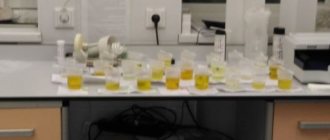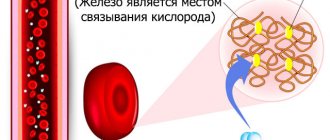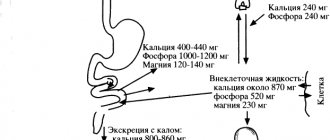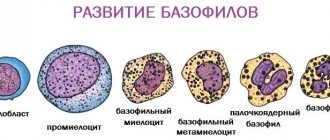- Treatment for increased free T4
In the female body, thyroid hormones affect all types of metabolism, the menstrual cycle and pregnancy. Thyroxine (T4) is one of two thyroid hormones synthesized by the thyroid gland. Two forms of thyroxine circulate in the blood - free (T4f, fT4) and protein-bound. To diagnose and treat various disorders, it is necessary to study and evaluate free T4 in women; a table of norms by age allows you to do this quickly.
Free T4 is a fraction of thyroxine not bound to proteins, the level of which in the blood depends on age
Free hormone thyroxine (T4), its functions
The hormone thyroxine is one of the most active substances containing iodine, which are indicators of the functioning of the endocrine system. Thyroxine is produced in the thyroid gland under the influence of thyroid-stimulating hormone.
The peculiarity of T4 is that this hormone affects the body in the long term and accumulates in cells and tissues, so its excess or deficiency harms all systems. Organs that are not affected by thyroxine include the testicles and spleen.
The level of penetration of thyroxine into cells is maximum. Most of the hormone is transported throughout the body along with protein and no more than 0.05% in free form. In this regard, in laboratory conditions a blood test is performed specifically for free thyroxine. For normal T4 production, the balance of zinc and selenium in the body is important.
Free T4 (the norm in women depends on the functioning of the thyroid gland) performs the following functions:
- accelerates metabolic processes by activating the synthesis of proteins and RNA;
- helps provide cells with oxygen;
- ensures calcium absorption;
- increases temperature;
- regulates the growth of bone tissue and epithelium of internal organs;
- helps strengthen the uterine lining;
- activates the nervous system;
- helps prepare the uterus for conception and gestation;
- stimulates mental activity;
- ensures ovulation in a woman’s body;
- promotes cell growth and tissue renewal;
- speeds up the heartbeat;
- controls protein synthesis;
- stimulates the production of vitamins and their absorption;
- regulates cardiovascular activity;
- reduces the risk of blood clots and blockage of blood vessels;
- ensures oxygen saturation of cells;
- regulates weight and normalizes growth;
- helps reduce cholesterol levels;
- ensures skeletal development;
- stimulates intracellular oxidation processes.
What is free thyroxine responsible for?
Thyroxine is a thyroid hormone containing iodine that is produced by the thyroid gland. When it penetrates the soft tissue, one of the iodine atoms is split off, causing T4 to become T3. To understand what kind of hormone this is, you need to consider its main functions.
More than 90% of thyroid hormones are total tetraiodothyronine.
In blood serum, T4 occurs in two states:
- unbound – free fractions of tetraiodothyronine (CT4), which do not form compounds with blood proteins;
- bound - hormone molecules that form organic compounds with globulin proteins.
Free T4 makes up no more than 0.1% of total tetraiodothyronine. But it is this fraction of the hormone that has high bioactivity. If the level of thyroxine in the body increases or decreases greatly, this affects hormonal levels and the functioning of internal organs.
Main functions of T4 free:
- regulates the speed of energy metabolism;
- lowers the concentration of cholesterol in the blood serum;
- controls physiological processes in the central nervous system;
- stimulates the production of retinol by liver tissue;
- controls the renewal of bone tissue cells;
- accelerates the breakdown of triglycerides;
- enhances the excretion of calcium through the kidneys.
T4 levels fluctuate throughout the day. Its maximum concentration is reached in the morning, and its minimum in the dead of night.
Thyroxine is characterized by seasonal fluctuations. T4 concentration reaches minimum values in the autumn-winter period, and maximum values in spring-summer.
Endocrinologists have established a relationship between the content of sex hormones and iodine-containing hormones in women. If progesterone or estrogen levels change dramatically, the concentration of unbound T4 will also be affected.
Norms for free T4 levels in women, men, children, and during pregnancy
Free T4 (the norm for women, men, and children may vary depending on the time of day) depends on the level of thyroid-stimulating hormone and iodine in the human body. The concentration of the T4 hormone reaches its peak from 8-00 to 12-00, and decreases to a minimum from 23-00 to 03-00.
There is also a strong dependence of thyroxine levels on the time of year: in summer - minimal, in autumn and winter - maximum. The norm of free T4 in men and children is higher than in women. Even with diseases of particular severity that are not related to the endocrine system and the thyroid gland, thyroxine remains within normal limits.
T4 (free): norm in women, men, children, table:
| Patient's age and gender | Thyroxine norm, pmol/l | |
| child | up to 4 months | 11,4 — 28,4 |
| 4 months - 1 year | 12,0 – 25,5 | |
| 1 year – 7 years | 12,4 – 22,9 | |
| 7 years – 12 years | 12,6 – 21,4 | |
| 12 years – 15 years | 12,7 – 20,9 | |
| men | 9,1 – 19,3 | |
| women | 8,1 – 17,5 | |
| women during menopause | 10,5 – 24,6 | |
The T4 hormone is free, the norm in women in the photo.
T4 (free): normal for women during pregnancy, table:
| Term | Thyroxine norm, pmol/l |
| 1 – 13 week | 12,0 – 19,7 |
| 14 – 28 weeks | 9,5 – 16,9 |
| 29 – 42 weeks | 8,5 – 15,5 |
What is free T4 in a blood test?
The T4 hormone stands for thyroxine or propionic acid. It is one of the two most important thyroid hormones. On its basis, triiodothyronine is formed during metabolic reactions.
The T4 hormone itself is formed from L-tyrosine when 4 iodine molecules are added to it. The biological activity of T4 is extremely low. Its activation requires the action of the enzyme selenium-dependent monodeiodinase. It converts thyroxine into triiodothyronine, which is characterized by high biological activity.
The total ratio of hormones produced by the thyroid gland is as follows: 4/5 is thyroxine, 1/5 is triiodothyronine.
Hormone synthesis is controlled by thyrotropin (TSH), which is deposited in the tissues of the thyroid gland. The need for accumulation is associated with its long period of functional activity, unlike other hormones.
The amount of T4 hormone synthesized depends on its concentration in the blood. The higher its level, the less amount will be released into the blood. When its concentration decreases, the inhibitory factors that prevent its release are blocked. The hormone begins to actively enter the blood. Its synthesis also depends on external factors. For example, when the human body is hypothermic for a long time, the production of thyroxine increases.
Read further: What is thyrotropin (TSH), how to properly donate blood for analysis?
Reasons for increasing hormone levels
A condition in which the level of the T4 hormone exceeds the norm is called hyperthyroidism, and its critical stage is called Graves' disease.
The reasons for the increase in the concentration of free thyroxine in the blood include the following:
- liver diseases (cirrhosis, hepatitis);
- impaired renal function (nephrosis, increased concentration of protein in the urine, impaired excretion of salts from the body, glomerular nephritis);
- tumors and inflammation of the endocrine gland (thyroiditis, adenoma);
- diffuse toxic goiter (an autoimmune disease, transmitted hereditarily and accompanied by poisoning with thyroid hormones);
- myeloma (systemic disease of the circulatory system);
- hyperfunction of the thyroid gland;
- childbirth;
- recent blood purification procedure using an artificial kidney device;
- taking medications in large quantities (insulin, aspirin);
- overweight, obesity;
- therapy with heparin;
- infection with human immunodeficiency virus;
- uterine tumor;
- mental disorders;
- hereditary disorder of thyroxine production;
- stress;
- use of drugs containing thyroid hormones.
When free T4 is higher than normal
The study may show an increase in the concentration of thyroxine, not bound to proteins, in a number of diseases and conditions of the woman’s body:
- diffuse toxic goiter;
- nodular toxic goiter;
- inflammation of the thyroid gland with a subacute course;
- hormonally active pituitary tumors, accompanied by excessive synthesis of thyrotropin;
- pituitary form of resistance (resistance) to thyroid hormones;
- uncontrolled long-term treatment with synthetic thyroid drugs;
- ovarian tumors from embryonic cells called teratomas;
- excessive intake of iodine into the body;
- choriocarcinoma (malignant neoplasm from the chorionic villi - the embryonic part of the placenta);
- chronic liver damage;
- nephrotic syndrome.
These are the main etiological factors. A slight increase in average hormone values is observed in the first 14 weeks of physiological pregnancy.
Reasons for low T4 levels
A deficiency of the hormone free thyroxine is known as hypothyroidism. In childhood, this condition is fraught with the development of cretinism, and in middle age - myxedema, which is accompanied by dysfunction of protein metabolism, swelling and fluid retention in the body.
Causes of hypothyroidism include:
- tumors and inflammation of the thyroid gland, pituitary gland;
- inflammatory processes in the body;
- head injuries;
- iodine deficiency in the body;
- recent surgery;
- heavy metals entering the body in large quantities;
- drug addiction;
- taking medications that inhibit the production of the T4 hormone, as well as anti-inflammatory and antifungal drugs;
- removal of the endocrine gland (partially or completely);
- low protein nutrition;
- diet, fasting;
- increase in the size of the thyroid gland;
- benign formation of the pituitary gland;
- taking hormonal contraceptives in the form of tablets;
- complications during childbirth, accompanied by bleeding and decreased blood pressure.
Functions
The biological effect of the T4 hormone is to regulate all metabolic processes in the body, and includes the following functions:
- increases metabolic rate;
- increases heat production;
- increases oxygen consumption;
- regulates bone growth;
- responsible for the development of the nervous system in early and teenage years;
- stimulates the absorption of vitamins and minerals;
- enhances oxidative processes in cells;
- participates in the regulation of the menstrual cycle;
- regulates the development of the embryo during pregnancy, promotes the production of vitamin A in the liver.
There are two forms of T4 - bound (in the form of compounds with transport proteins: globulin, prealbumin and albumin) and free (without proteins that bind thyroxine).
Symptoms of low T4 levels
Among the symptoms of reduced levels of free thyroxine are the following:
- powerlessness, lethargy;
- the appearance of pigment spots on the skin;
- sore throat;
- muscle weakness;
- aggravation of the emotional background;
- disruptions of the menstrual cycle;
- difficulties of the conception process;
- intestinal obstruction and constipation;
- abnormal heart rhythm;
- delayed physical and mental development;
- cardiac ischemia;
- weight gain along with poor appetite;
- dry skin;
- brittle nails and hair;
- depression;
- inhibition of reactions;
- constant and unreasonable feeling of cold.
It is impossible to completely normalize low levels of the hormone thyroxine, therefore, in case of hypothyroidism, as a rule, a substitute obtained in the laboratory is used.
What is thyroxine
Thyroxine is the main group of thyroid hormones. It is a prohormone for the formation of triiodothyronine (T3), a more active form. Thyroxine is formed by combining iodine and L-tyrosine. Synthesis is carried out by the follicular gland, the whole process is controlled by the hormone TSH.
The hormone accumulates in the tissues of the gland and acts for a long time. That is why it is considered one of the most important for the normal functioning of the body. It has the ability to penetrate membranes and connect with receptors in all cells of the body.
What is he responsible for?
Thyroxine helps increase overall metabolism, participates in heat exchange reactions and cholesterol conversion, and normalizes the absorption of glucose in the intestinal area. In children, T4 normalizes the activity of somatropin, a growth hormone. After entering the blood, no more than 0.5% of the total concentration of thyroxine does not bind to protein fractions. After this, T4 is either converted to T3 or continues to move unhindered throughout the body, reaching target organs.
Differences between common and free
Total T4 is the total concentration of thyroxine, which is in the blood plasma at the time of the study. These are both bound and free fractions of T4, which give an idea of how much of the hormone is present in the body at a given time. Bound T4 attaches to transport proteins that deliver the hormone to the peripheral organ area. This form does not have a hormonal effect, is not destroyed when passing through the liver and kidneys, and is found in high concentrations in the blood plasma.
The receptors for bound T4 are bound by protein fractions, so it is not able to have a certain effect and continue to circulate in the body for a long time.
The concentration of free thyroxine is up to 0.05% of the total. This is a biologically active fraction, which is more informative when studying patients with suspected hypo- or hyperthyroidism (reduced or increased thyroid function). T4 is able to penetrate the cell nucleus, activating the production of ribonucleic acids, which leads to an acceleration of the processes of division and renewal.
To summarize, it should be noted that:
- free T4 is not bound by proteins;
- is present in the blood plasma in low concentrations and not for a limited period of time;
- prone to destruction when passing through the liver and organs of the urinary system;
- can move independently along with the blood flow;
- promotes hormonal effects on the body.
T4 is the precursor of T3. Indicators may remain within normal limits in other pathological conditions that are not related to the functioning of the thyroid gland.
Symptoms of high T4 levels
An increased concentration of the T4 hormone can occur as a result of pathologies, as well as as a consequence of taking medications containing the hormone. Girls use such drugs to lose weight, without thinking about the harm to the body.
When the level of free thyroxine is high, the following symptoms appear:
- baldness;
- wet palms;
- difficulty swallowing;
- unblinking gaze;
- low voice and hoarseness;
- swelling of the face;
- insomnia;
- diarrhea and diarrhea;
- high photosensitivity;
- loss of vision;
- menstrual dysfunction;
- excessive sweating, fever;
- irritability, sudden mood swings, short temper;
- attacks of hysteria;
- paranoid attacks;
- arrhythmia, rapid pulse and palpitations;
- anorexia;
- redness of the eyes;
- convulsions, tremors;
- calcium leaching, which increases the risk of limb fractures;
- dysfunction of all internal organs and their rapid wear are observed;
- toxic goiter and protrusion of the eyes.
Diagnostics
To obtain information about the functioning of the thyroid gland, a thyroxine test is prescribed in conjunction with a laboratory determination of the level of thyroid-stimulating hormone (especially if the level of thyroxine-binding globulin fluctuates during pregnancy, in the case of the use of androgen and estrogen drugs) and triiodothyronine. The main functions in the body are performed by the free fractions of thyroxine and triiodothyronine. The study of antibodies to thyroid peroxidase and thyroglobulin is of diagnostic importance.
Rules for preparing for donating blood for analysis:
- If the patient is taking thyroxine medications, you can donate blood for analysis only before taking it, otherwise a distorted result will be obtained.
- On the day before donating blood, stress and excessive physical activity should be avoided.
- Before analysis, you need to remove fatty foods from your diet.
- It is recommended to donate blood in the morning on an empty stomach (at least 8 hours must pass after the last meal).
Different laboratories may use different research methods, the standards for thyroxine levels in the blood may differ, and in addition, different laboratories may use different units of measurement for the concentration of free thyroxine in the blood (pmol/l, ng/dl, ng/l, pg/ml and etc.), which should also be taken into account. If it is necessary to repeatedly determine thyroid function indicators, it is best to take tests at the same medical institution.
When is a test to determine T4 levels prescribed?
The production of thyroxine directly depends on the work of the pituitary gland. If T4 levels decrease, the pituitary gland releases hormones that activate the thyroid gland to normalize the concentration of thyroxine. An endocrinologist, therapist or gynecologist can prescribe an analysis to determine the level of thyroxine in the blood if there are corresponding symptoms or during a routine examination.
As a rule, a study is carried out of the concentration of the free hormone T4 in the blood, since its level does not depend on the binding protein. Deviation from the norm T4 allows us to evaluate the functioning of the thyroid gland.
For healthy people, it is advisable to conduct an examination and take an analysis for the level of free thyroxine once a year, and in the case of dysfunction of the hormonal system, at least once every six months. For patients suffering from thyroid disorders, it is recommended to have T4 blood taken every 3-4 months.
During pregnancy, an appropriate test is also taken, since this hormone is important not only during the conception of a child, but also during pregnancy. Deviation of thyroxine levels from the norm can lead to complications during childbirth, during pregnancy, and also cause defects in the development of the fetus.
In the first trimester, the concentration of the hormone is the highest, since during this period it contributes to the formation of the fetal nervous system. At the same time, excessive T4 levels during pregnancy require urgent but careful medical intervention.
The study of thyroxine content in the blood is used in the diagnosis of endocrine disorders, infertility, as well as in cases of suspected hereditary or acquired hypothyroidism or hyperthyroidism.
Also, the basis for mandatory testing for T4 in women is:
- severe toxicosis during pregnancy;
- risk of miscarriage;
- infertility;
- defects and delays in the development of the embryo;
- diabetes;
- multiple pregnancy.
The norm of free thyroxine hormone
To draw any conclusions from a patient’s tests, you need to know the norms of free T4 hormone. It does not depend on gender, but changes as you grow older. Also, the amount of free thyroxine changes during pregnancy to a lesser extent.
Normal thyroxine levels are specific to each laboratory because equipment and reagents vary. Medical supply of a new level implies established standards within the range of 9-20 pmol/l in a healthy adult.
Among women
The rate of free T4 does not depend on gender, but total thyroxine is higher in women. Free T4 in women varies from 9.0 to 22.0 pmol/l.
During pregnancy, the amount of the hormone may increase in the first trimester, but by the third it gradually decreases to 7.6-18.6 pmol/l.
During pregnancy, the activity of sex hormones - estrogen and progesterone - increases in a woman’s body, which, in turn, can influence thyroid hormones. At the same time, the secretion of transport proteins, which are involved in the transport of thyroid hormones, also increases.
The concentration of tetraiodothyronine during pregnancy plays a huge role:
- The formation of the child’s nervous system in the first trimester depends on it.
- Therefore, if a woman has not been examined at the pregnancy planning stage, but the amount of thyroxine is insufficient, the risk of congenital pathologies of the fetus increases.
It is pointless to measure total thyroxine levels during pregnancy because they can be high due to the large amount of protein. This figure will always be higher than normal if a woman is carrying a baby.
A slight increase in free T4 is acceptable if the value does not exceed the upper limit of normal.
Attention! If there is a lack of free thyroxine, hormone therapy is prescribed, which is carried out under the constant supervision of a doctor.
In men
In a normal healthy adult male, the T4 value is stable and equal to 9.0-20.0. After 40-45 years, the concentration of the hormone decreases.
In children
In childhood, the amount of thyroxine can vary. The data is given below.
- Newborns (up to 15 days) - from 13.47 to 41.32 pmol/l;
- 15-30 days - from 8.71 to 32.53 pmol/l;
- From 1 to 12 months - from 11.42 to 21.89 pmol/l;
- From 1 year to 18 years - from 11.43 to 17.59 pmol/l.
Thyroid hormones in normal and pathological conditions are described in the video:
Rules for taking a blood test for T4 (preparation, blood sampling)
Women are recommended to conduct a study of free thyroxine levels on the 7th day of the cycle.
Before taking a T4 test, you need to prepare your body as follows:
- 1.5 months before the test, you should refrain from taking medications containing the hormone. Otherwise, the study will not show the amount of hormone secreted directly by the thyroid gland.
- You must stop taking oral contraceptives 2 weeks before.
- a week before donating blood for thyroxine, it is better to reduce physical and mental stress to a minimum.
- 3-4 days before the test you should refrain from using iodine-containing medications.
- Avoid taking medications containing steroids for 2 days.
- One day, completely stop drinking alcoholic beverages.
- Do not smoke 4-5 hours before the test.
- Immediately before taking blood, you should sit quietly for half an hour.
The analysis takes place in the morning. Doctors also recommend skipping dinner and breakfast on the eve of the study. During this period of time, you can only drink water without gas. It is also necessary to protect the body from stressful situations. Blood sampling cannot be carried out immediately after an X-ray contrast examination.
The material for the study is venous blood, which is subjected to immunochemiluminescent study. Testing for free thyroxine is also possible on biomaterials. Venous blood is collected in a volume of 8.5 ml. The material can be stored at a temperature of +2 - +25 oC for no more than a day.
Reasons for the decrease in free thyroxine in the blood
Typically, low T4 indicates a lack of iodine in the body. The hormone in the blood can decrease with:
- thyroiditis (inflammatory disease of the thyroid gland);
- benign and malignant tumors in the thyroid gland and brain;
- traumatic brain injury;
- poisoning of the body with salts of heavy metals;
- sudden weight loss due to starvation diet;
- excessive physical and emotional stress.
In women, free T4 levels fall when taking oral contraceptives.
How long to wait for the results of the study? Decoding answers
The results of studying the level of free thyroxine can be obtained within 1-2 days. Due to the fact that different laboratories use their own set of reagents, the limit values of the hormone may differ (as a rule, they are indicated in the results form).
Exceeding the thyroxine norm may indicate pregnancy, obesity, and the development of inflammatory processes in the liver and thyroid gland.
At the same time, low T4 levels are accompanied by thyroid deficiency, Cushing's syndrome, and panhypopituitarism. As a rule, a T4 test is taken along with blood for thyroid-stimulating hormone. In the case of elevated TSH along with low T4, one can conclude that the patient has manifest hypothyroidism.
If TSH is high, while T4 is normal, subclinical hypothyroidism is observed. When TSH is within the normal range and T4 is below it, the analysis is reassigned. Excessive T4 levels along with low TSH indicate thyrotoxicosis.
T4 hormone during pregnancy
Thyroxine is most actively produced during gestation, reaching its highest concentration in the 1st – 2nd trimester.
At the same time, increased free T4 in women who are preparing to become mothers is a physiological phenomenon.
Thyroxine in expectant mothers is responsible for the normal development of organs and tissues of the embryo and fetus. If there are significant disruptions in the functioning of the mother’s gland, there is a threat to the health of the expected child. A hormone production disorder can cause miscarriage and intrauterine defects in a baby (spina bifida).
Women prone to thyroid diseases (including hereditary factors) or patients diagnosed with endocrine pathologies are recommended to take a free T4 test for early detection of any deviations from the norm.
Reference values according to gestational age. Table 3
| Duration in weeks | Reference interval, pmol/l |
| up to 13 | 12,1 — 19,6 |
| 13 — 28 | 9,5 – 17,5 |
| from 29 weeks until birth | 8,4 — 15,6 |
Changes in hormonal status during gestation are not dangerous if the indicators are within the range of reference values established for expectant mothers. However, you should carefully monitor fluctuations in the concentration of thyroxine in order to take timely action if its level begins to fall outside the normal range or is on the “border” of the range.
Treatment for changes in T4 levels in the blood
Any deviation in the level of thyroxine in the blood requires medical intervention. Depending on whether free T4 is increased or decreased, various drugs are used.
T4 hormone is increased
An increased concentration of thyroxine does not apply to diseases in their pure form. At the same time, due to the self-regulatory function of the body, along with the high level of T4, the production of thyroid-stimulating hormone is reduced.
Depending on how high the concentration of the free thyroxine hormone is and what the state of the body as a whole is, in the treatment of hyperthyroidism, appropriate drugs are used, surgery is performed, or the normal functioning of the thyroid gland is resumed.
The main goal of drug therapy is to reduce T4 levels by eliminating excess hormones. Such treatment is quite long and can last several years. At the beginning of therapy, large doses of medication are taken in order to bring thyroxine levels back to normal. Then, to maintain the hormone within normal limits, the dosage of the medication is reduced.
This method has a number of side effects, such as:
- anemia;
- allergy;
- enlargement of the thyroid gland;
- liver disorders as a result of an increase in the enzymes it produces;
- intestinal disorders;
- migraine;
- disruptions in the menstrual cycle in women.
Sometimes medications are used to block thyroid function, allowing it to recover. At the same time, the patient is prescribed hormonal medications containing synthetic thyroxine.
Drug treatment does not always lead to a 100% result: relapses occur in ¾ of cases. Moreover, if there is no visible result after a year of such therapy, it is stopped and other procedures are used. The definitive method of combating hyperthyroidism is to remove the thyroid gland through surgery or radioactive iodine therapy.
This treatment has lifelong benefits. At the same time, after such procedures the patient is doomed to take hormonal drugs for the rest of his life. Surgical intervention is advisable when the thyroid gland is significantly enlarged, which allows only part of it to be removed, while the remaining portion of this organ will continue to function.
Radioactive iodine therapy cannot be used in the treatment of pregnant women or women planning to give birth, as it is fraught with deviations in the development of the fetus.
A more modern method of getting rid of hyperthyroidism includes computer reflexology, which promotes the resumption of normal activity of the thyroid gland. This method is based on the impact of small current on specific points associated with the brain. This intervention eliminates immune failures and has virtually no relapses.
Hyperthyroidism can result from inflammation of the thyroid gland. Because of this, the hormone, with the same production, is only released into the blood faster. This phenomenon is usually short-lived and does not require drastic treatment methods. Also, due to stress, T4 may exceed the norm, but in this case, treatment is absolutely unnecessary.
T4 hormone is low
Unlike hyperthyroidism, low thyroxine levels cannot be completely normalized in most cases. Treatment is supportive and mostly lifelong. Drug therapy for hypothyroidism does not cause side effects, since the hormone contained in the drugs is similar to the natural one.
There are absolute and relative hypothyroidism. With the absolute type of T4 deficiency, there is a lack of hormone production, while the relative type is characterized by poor susceptibility of organs and tissues to this hormone.
According to the degree of development of hypothyroidism, there are:
- latent (TSH is above normal, T4 is within normal limits);
- manifest (TSH is above normal, T4 is slightly decreased);
- with complications (TSH is higher than normal, T4 is critically low).
To restore thyroid function in hypothyroidism, the following methods are simultaneously used:
- phytotherapy;
- reflex therapy (massage, acupuncture);
- taking hormonal medications containing thyroxine;
- restoration of the nervous system;
- increasing immunity.
Due to the fact that the main primary source of low levels of thyroxine in the body is iodine deficiency, the patient is recommended to introduce foods containing this microelement in large quantities into the diet. Iodine-saturated foods include seafood (fish, seaweed).
Hypothyroidism, in the absence of comprehensive treatment, can lead to disorders of the nervous system, mental retardation, and cretinism. There may also be disturbances in the functioning of the respiratory system, heart, immune system, development of infertility and cancer.
With hypothyroidism in older people, hypothyroid coma may occur.
Low levels of the hormone thyroxine in pregnant women do not require treatment, since it occurs against the background of the body’s adaptation to the process of bearing a child. Thus, the free hormone thyroxine (T4) plays an important role in the functioning of the human body and needs to be constantly maintained within normal limits in both women and men.
Article design: Oleg Lozinsky
What functions does T4 perform in the female body?
It has been established that the hormone is capable of affecting all cells and tissues. There are no specific target cells for it that show or block sensitivity to it.
The main function is to enhance metabolic processes by stimulating the replication of RNA and essential proteins. The hormone can influence thermoregulation, growth and development of the body. This occurs by activating protein synthesis. Without it, the normal process of differentiation of maturing cells and the full implementation of oxidative reactions are impossible.
T4 is also able to increase heart rate, stimulate thickening of the mucous layer in the uterus, enhance redox processes in nerve tissues, participate in cell differentiation, etc.
Deviations from the norm
Endocrinologists primarily pay attention to the patient’s general well-being and clinical picture. Indicators may remain within normal limits, but health gradually worsens. Pay attention to subclinical signs: teeth marks on the sides of the tongue, general weakness and fatigue, marks from socks or jeans on the ankles. Deviations from the norm according to the results of laboratory tests are an indication for an in-person consultation with the attending endocrinologist and additional research.
Causes
A drop in T4 to the lower third of the reference value is a clear indication of hyperthyroidism. This condition most often occurs in females.
Violation of T4 norms (decrease) can also be caused by:
- deficiency of co-factors that are required for the normal functioning of the thyroid gland: iodine, selenium, iron, B vitamins, vitamin D, zinc, ascorbic acid, protein
- chronic inflammation in the body
- pregnancy
- poor diet, prolonged fasting
- hypothyroidism
- autoimmune thyroiditis
- resection of the thyroid gland
- inflammatory processes affecting the hypothalamus and pituitary gland
- lead intoxication
- using medications from the group of oral contraceptives
T4 can increase with thyrotoxicosis, hyperthyroidism, overdose of thyroid hormones, diffuse and toxic goiter, obesity, thyroid adenoma, kidney dysfunction, chronic liver pathologies, and the use of drugs containing heparin in the period after the birth of a child.
Symptoms
The doctor prescribes a T4 test for manifestations that may indicate hyperthyroidism:
- cardiopalmus
- increased irritability
- insomnia
- weight loss
- limb tremors
- weakness, increased fatigue
- diarrhea
- intolerance to bright light
- dysfunction of the visual organs, swelling around the eyes
- dryness and redness of the skin
- bulging eyes
T4 is also a mandatory diagnostic criterion for symptoms associated with hypothyroidism:
- weight gain
- dry skin
- cold intolerance
- formation of edema
- hair loss
- menstrual irregularities
- heart rhythm disturbances
The clinical picture of hypo- or hyperthyroidism can be blurred, therefore clinical studies of free T4 indicators are an obligatory element of a comprehensive diagnosis of thyroid dysfunction. Additionally, the doctor checks the level of ferritin, microelements, and vitamin D.











